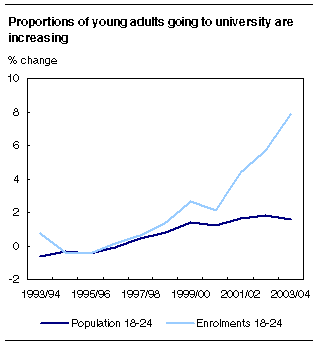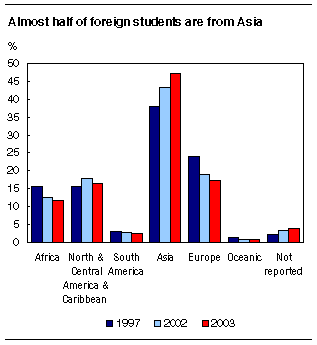
















 |
|
 |                |
Information identified as archived is provided for reference, research or recordkeeping purposes. It is not subject to the Government of Canada Web Standards and has not been altered or updated since it was archived. Please "contact us" to request a format other than those available.

|

Tuesday, October 11, 2005 University enrolment2003/04Enrolment at Canadian universities recorded its strongest increase in 28 years during the academic year 2003/04, due to a rise in the number of students aged 18 to 24, Ontario's double cohort and a record gain in students from other countries. 
In total, 990,400 students were enrolled in universities in 2003/04, up 6.1% from the previous year and 20.4% higher compared with 1997/98. It was the sixth consecutive year in which enrolment hit a record high.
Enrolment within the 18 to 24 age group has risen at a faster pace than the increase in total university enrolment. The student population in this age group rose 27.5% between 1995/96 and 2003/04. This was due to two factors. First, there were more people aged 18 to 24 with the arrival of the echo-boom generation, that is, children born between 1980 and 1995. Second, the proportions of young adults going to university increased. The restructuring of the Canadian economy over the past quarter century appears to have had an impact on demand for university education and the expectation of students on labour market requirements. Many more entry-level jobs in today's economy require higher postsecondary qualifications than in the past. Ontario's double cohort was also a major factor in the rising university enrolment rate. In 2002/03, two cohorts of students graduated from Ontario secondary schools at the same time because of the elimination of Grade 13 Ontario Academic Courses (OAC) from the Ontario curriculum. Therefore, Grade 12 and Grade 13 OAC students entered university simultaneously and increased the number of enrolments in 2003/04, especially for 18 year old students. In addition, a record 70,000 students from other countries enrolled in programs at Canadian universities in 2003/04, up 16.8% from the previous year. Almost 5 out of every 10 foreign students were from Asia, and China accounted for almost 44% of these Asian students. Women now account for 6 out of every 10 undergradsFemale students continued to outnumber their male counterparts at both the graduate and undergraduate levels. Women accounted for 59% of all undergraduate registrations in university in 2003/04, their highest proportion ever. They also represented 51% of graduate students. The number of female undergraduate students rose 7.5% to 456,900 in 2003/04, while the number of male undergrads increased 6.0% to 319,900. At the doctorate level, enrolment climbed 9.1% between 2002/03 and 2003/04, the biggest increase compared to enrolment in bachelor's and other undergraduate degree and master's programs. A record high 32,000 students were seeking their PhD in 2003/04. Men still outnumbered women at the doctorate level, accounting for 54% of enrolment in 2003/04. However, since 1997/98, the rate of growth in enrolments for men at the doctorate was less than for women. In 1997/98, the proportion of men enrolled at the doctorate level was 57%. Enrolment at the doctorate level has increased 18.5% since 1997/98, largely because of gains in architecture, engineering and related technologies, and in physical and life sciences and technology. In 2002/03, for the first time, the number of enrolments at the doctorate level in architecture, engineering and related technologies surpassed the number of registrations in humanities. There were 89,400 students enrolled in a master's program in 2003/04, up 4.2% from the previous year and 28.0% higher compared with 1997/98. Women accounted for 52% of enrolment, a proportion that has remained stable since 1997/98. Full-time student enrolment reached a record high of 735,600 in 2003/04, while part-time enrolment fell to 1999/2000 levels. Share of foreign students nearly doublesForeign students accounted for 7% of the university population in 2003/04, nearly double the proportion of 4% a decade earlier. Several factors might explain the substantial growth. They include strong economic growth in leading Asian countries, such as China; new university marketing strategies to counter competition from institutions in other countries; changes in immigration policies; and provincial agreements with other countries to attract foreign students. Asian students accounted for nearly 70% of the total increase in foreign students between 2002/03 and 2003/04. Compared to 2002/03, the number of students from China rose by 45%. Canadian universities also received large numbers of students from South Korea, Japan, Hong Kong and India. The number of students from those nations increased in 2003/04, except for Hong Kong (-2%). About one-fifth of foreign students came from Europe and 16% from North America and Central America and the Caribbean. Almost half of the European students enrolled in Canada were from France. Overall, more than one-third of foreign students were enrolled in Ontario universities and 30% in Quebec universities. British Columbia universities accounted for 11% and Alberta universities 8%. Among foreign students, both undergraduate and graduate level enrolments increased substantially in 2003/04 compared to the previous year. Undergraduate enrolments rose 21% and the graduate student population rose 15%. 
Enrolment up in almost every field of studyUniversity enrolment rose in almost every field of study in 2003/04. The only major field to register a decline was mathematics, computer and information sciences, where the student population fell 3.2%, the second consecutive decline. This decrease was driven by a 7.5% drop in enrolment in computer and information sciences and support services. The biggest gain occurred in the field of business, management and public administration (+11.6%), where the number of students surpassed 170,900. Business, management and public administration has led enrolment since 1999/2000. The second largest increase in enrolment occurred in physical and life sciences and technology (+10.0%), which includes among others, physical, biological and biomedical sciences. Since 1997/98, enrolment in this field of study has risen by 20.5%, partly due to the increased participation of women. Women now account for 56% of all students in this field. The second largest field of study was social and behavioural sciences, where enrolment reached 162,300. Women represented two-thirds of the student population in this field. Full-time university enrolment at the provincial levelAll provinces saw their number of students rise in the 2003/04, with increases ranging from 0.9% in Saskatchewan to 9.6% in Ontario. During the last six years, the increase in full-time enrolment was such that all provinces saw their numbers exceed those for 1997/98. Part-time enrolment increased in every province except British Columbia and Quebec (which both posted declines) during the six-year period. Available on CANSIM: table 477-0013. Definitions, data sources and methods: survey number 5017. Data tables are also available in the Canadian Statistics module of our Web site. For general information or to order data, contact Client Services (1-800-307-3382; 613-951-7608; fax: 613-951-9040; educationstats@statcan.gc.ca).
| ||||||||||||||||||||||||||||||||||||||||||||||||||||||||||||||||||||||||||||||||||||||||||||||||||||||||||||||||||||||||||||||||||||||||||||||||||||||||||||||||||||||||||||||||||||||||||||||||||||||||||||||||||||||||||||||||||||||||||||||||||||||||||||||||||||||||||||||||||||||||||||||||||||||||||||||||||||||||||||||||||||||||||||||||||||||||||||||||||||||||||||||||||||||||||||||||||||||||||||||||||||||||||||||||||||||||||||||||||||||||||||||||||||||||||||||||||||||||||||||||||||||||||||||||||||||||||||||||||||||||||||||||||||||||||||||||||||||||||||||||||||||||||||||||||||||||||||||||||||||||||||||||||||||||||||||||||||||||||||||||||||||||||||||||||||||||||||||||||||||||||||||||||||||||||||||||||||||||||||
|
|
|